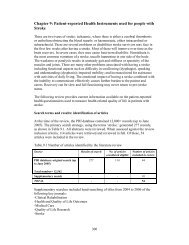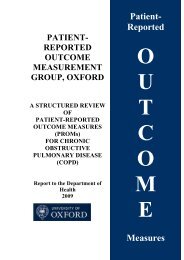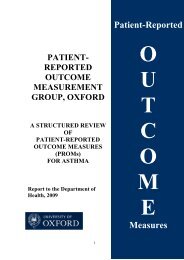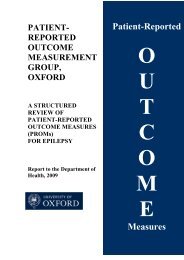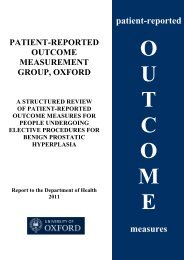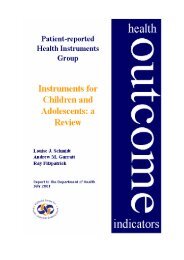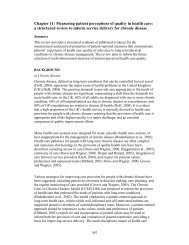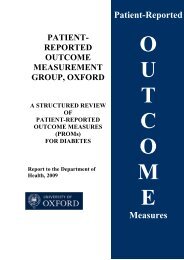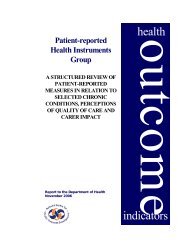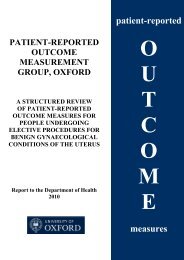2010 review - Patient-Reported Outcomes Measurement - University ...
2010 review - Patient-Reported Outcomes Measurement - University ...
2010 review - Patient-Reported Outcomes Measurement - University ...
Create successful ePaper yourself
Turn your PDF publications into a flip-book with our unique Google optimized e-Paper software.
larger than for the SF-36 SF and MH subscales, although PF scales of the two measures were<br />
comparable (Schroter & Lamping, 2006, UK). In the PTCA sample, the SRM for CROQ<br />
Symptoms was significantly larger than for the SAQ Anginal Frequency scale, but the SRM<br />
for CROQ PF was significantly lower than for SAQ Exertional Capacity (Schroter &<br />
Lamping, 2006, UK). The ES for CROQ PF was significantly larger than for SF-36 PF and,<br />
as in the CABG group, ES and SRM for the CROQ Psychosocial scale were significantly<br />
larger than for SF-36 SF and MH (Schroter & Lamping, 2006, UK).<br />
Responsiveness of the CROQ was further illustrated in a trial comparing the clinical<br />
effectiveness of MIDCAB versus PTCA (Reeves et al., 2004, UK; HTA report). CROQ<br />
scores favoured MIDCAB; however, between-group differences were statistically significant<br />
only in the cognitive functioning domain, at three months (Reeves et al., 2004, UK). As the<br />
authors of this study have noted, given the number of comparisons carried out (five and six<br />
dimensions/scores at three different time points), a single significant finding should be<br />
interpreted with caution (Reeves et al., 2004, UK).<br />
Acceptability of the CROQ was supported by response rates of over 80% in the original<br />
development study (Schroter & Lamping, 2000, UK), and a return rate of 87% for a battery<br />
including the CROQ in the BHACAS trial (Ascione et al., 2004, UK); both studies used<br />
postal administration. In the BHACAS trial (Ascione et al., 2004, UK), completion rates for<br />
CROQ items were slightly higher than for the SF-36 and SAQ, suggesting that patients in this<br />
sample found the measure easier to answer and/or more relevant to their circumstances<br />
(Ascione et al., 2004, UK). There was a response rate of 72% and 62% for the CABG and<br />
PTCA groups, respectively, in the postal survey comparing CROQ, SAQ, and SF-36<br />
(Schroter & Lamping, 2006, UK); of those who responded, 89% and 94%, respectively,<br />
completed the questionnaires post-revascularisation (Schroter & Lamping, 2006, UK).<br />
Time required for completion of the measure is estimated by the developers to be 10 minutes.<br />
c. Duke Activity Status Index, DASI (Hlatky et al., 1989)<br />
The DASI was developed to provide a means of assessing functional capacity in cardiac<br />
patients that would be more accurate and feasible to apply than existing measures, namely,<br />
the NYHA and CCS classification systems (Criteria Committee of the NYHA, 1994;<br />
Campeau, 1976), and the Specific Activity Scale (Goldman et al., 1981). It comprises 12<br />
items representing major aspects of physical function, each weighted according to the known<br />
metabolic cost of the activity (MET units); a difference of 2.2 units or greater has been shown<br />
to be clinically significant (Hlatky et al., 1997). Although its content is not strictly<br />
cardiovascular-specific, and it has been used with other clinical populations (see, for<br />
example, Carter et al., 2002), the DASI is generally regarded as a condition-specific measure,<br />
and is widely used with cardiovascular populations. An eight-item version has been<br />
developed to reduce patient burden, and with a modified scoring system (Phillips et al., 1990;<br />
Alonso et al., 1997).<br />
Sixteen studies supporting the use of DASI with patients undergoing CABG or PCI were<br />
identified; all were with North American samples. Fourteen studies examined outcomes of<br />
CABG; seven studies examined PCI (six studies examined both). Three studies are very<br />
recent.<br />
24



